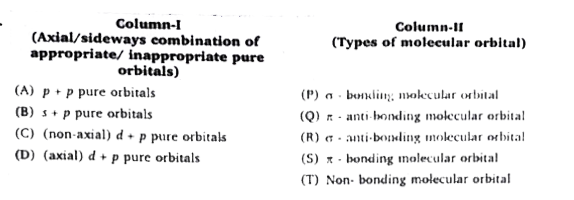Column-I and Column-II contains fore entries each. Entries of Column-I are to be matched with some enties of Column-II One or more than one entries of Column-I may have the matching with the same entries oc Column-II.
ColumnIColumnII(A)Electron(P)Negetive charge(B)Proton(Q)Positive charge(C)Neutron(R)1.6×10−19C(D)Positron(S)ChargelessSolution in Telugu
Step by step video & image solution for Column-I and Column-II contains fore entries each. Entries of Column-I are to be matched with some enties of Column-II One or more than one entries of Column-I may have the matching with the same entries oc Column-II. {:(,"ColumnI",,"ColumnII"),((A),"Electron",(P),"Negetive charge"),((B),"Proton",(Q),"Positive charge"),((C),"Neutron",(R),1.6xx10^(-19)C),((D),"Positron",(S),"Chargeless"):} by Chemistry experts to help you in doubts & scoring excellent marks in Class 11 exams.
Updated on:21/07/2023Topper's Solved these Questions
Similar Questions
For similar orbitals having different values of n:
View SolutionA small particle of mass m moves in such a way that the potential energy U = ar2 where a is a constant and r is the distance of the particle from the origin. Assuming Bohr's model of quantization of angular momentum and circular orbits, find the radius of nth allowed orbit.
View SolutionCalculate ΔrG for the reaction at 27∘C
H2(g)+2Ag+(aq)⇔2Ag(s)+2H+(aq)
Given : PH2=0.5 bar, [Ag+]=10−5M,
[H+]=10−3M,ΔrG∘[Ag+(aq)]=77.1kJ/mol
View SolutionColumn-I and Column-II contains fore entries each. Entries of Column-I are to be matched with some enties of Column-II One or more than one entries of Column-I may have the matching with the same entries oc Column-II. {:(,"ColumnI",,"ColumnII"),((A),"Electron",(P),"Negetive charge"),((B),"Proton",(Q),"Positive charge"),((C),"Neutron",(R),1.6xx10^(-19)C),((D),"Positron",(S),"Chargeless"):}
View SolutionEntries of Column-I are to be matched with entrices of Column-II. Each entry of Column-I may have the matching with one or more than entries of Column-II
View SolutionColumn-I and Column-II contains four entries each. Entries of Column-I are to be matched with some entries of Column-II. One or more than one entries of Column-I may have the matching with the same entries of Column-II and select the correct answer using the code given below the Columns
View SolutionColumn-I and Column -II contains four entries each. Entries of Column-I are to be matched with some entries of Column-II. One or more than one entries of Column-I may have the matching with the same entries of Column-II.

View SolutionColumn-I and Column-II contains four entries each. Entries of Column -I are to be matched with some entries of Column-II. One or more than one entries of Column-I may have the matching with the same entries of Column-II.

View SolutionEntries of Column-I are to be matched with entrices of Column-II. Each entry of Column-I may have the matching with one or more than entries of Column-II
View SolutionEntries of Column-I are to be matched with entrices of Column-II. Each entry of Column-I may have the matching with one or more than entries of Column-II
View SolutionEntries of Column-I are to be matched with entrices of Column-II. Each entry of Column-I may have the matching with one or more than entries of Column-II
View SolutionEntries of Column-I are to be matched with entrices of Column-II. Each entry of Column-I may have the matching with one or more than entries of Column-II
View SolutionEntries of Column-I are to be matched with entrices of Column-II. Each entry of Column-I may have the matching with one or more than entries of Column-II
View SolutionEntries of Column-I are to be matched with entrices of Column-II. Each entry of Column-I may have the matching with one or more than entries of Column-II
View SolutionEntries of Column-I are to be matched with entrices of Column-II. Each entry of Column-I may have the matching with one or more than entries of Column-II

View SolutionEntries of Column-I are to be matched with entrices of Column-II. Each entry of Column-I may have the matching with one or more than entries of Column-II

View Solution
